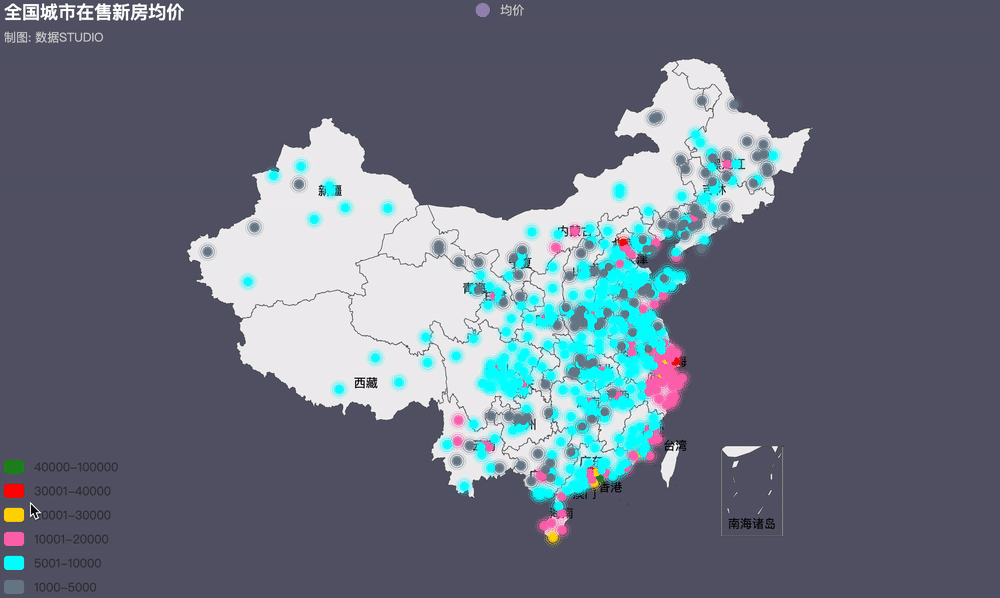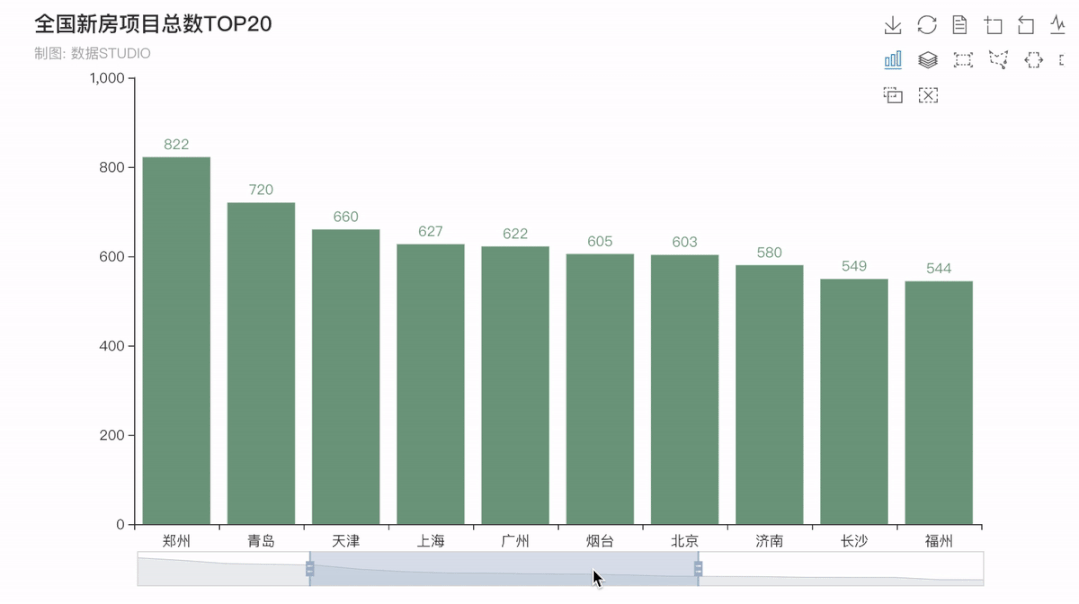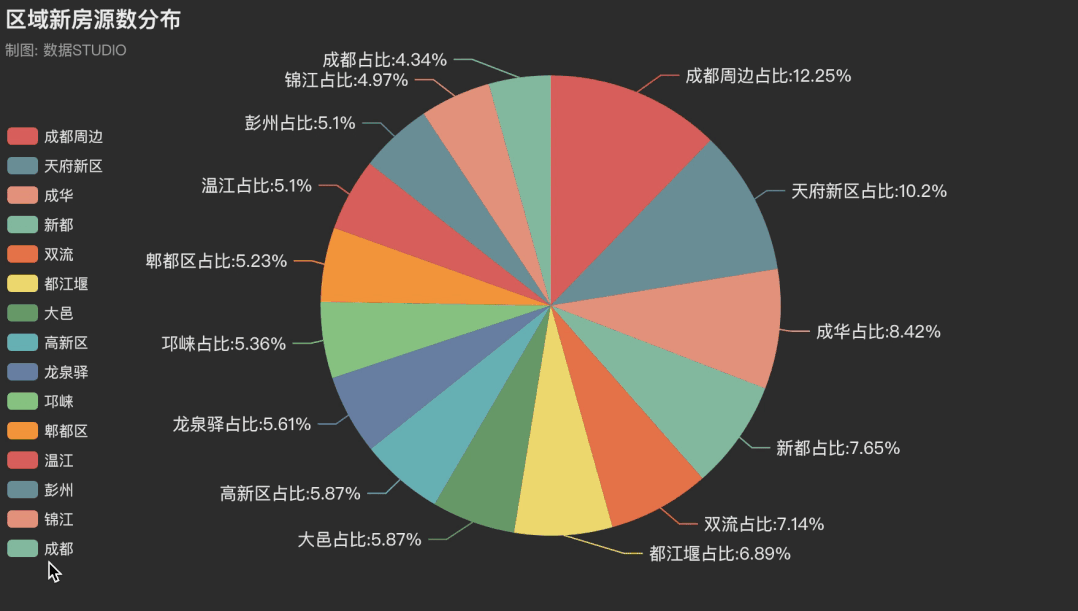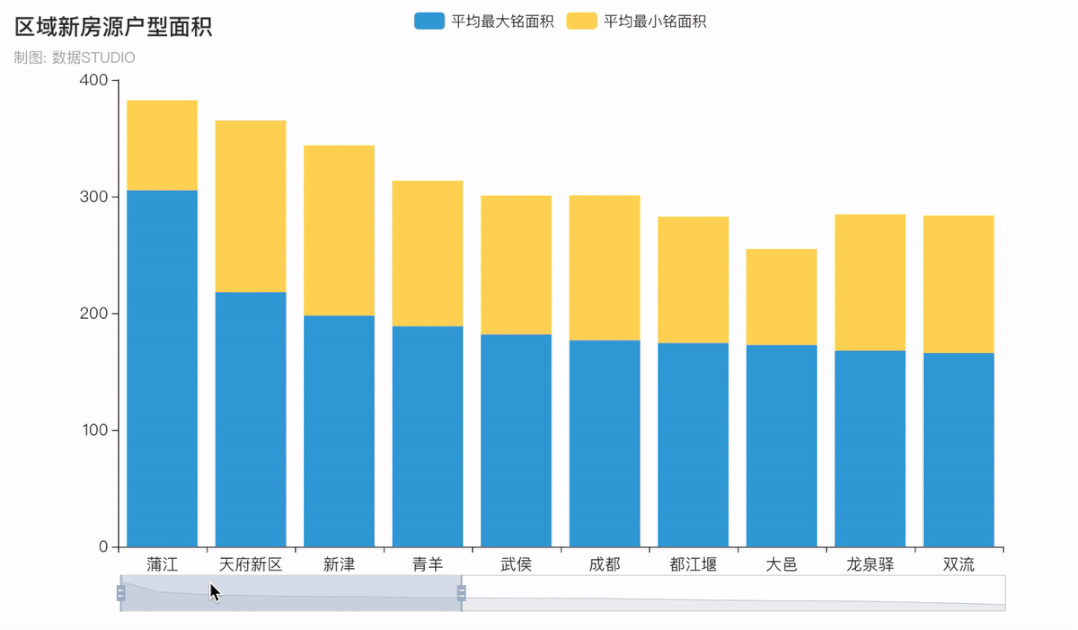前言
本文的文字及图片来源于网络,仅供学习、交流使用,不具有任何商业用途,如有问题请及时联系我们以作处理。
以下文章来源于数据STUDIO ,作者 云朵君
十三届全国人大四次会议5日上午9时在人民大会堂开幕,其中住房政策:“房住不炒”,解决好大城市住房突出问题。
本文通过爬取全国各城市在售新房,进行可视化分析。
数据获取
通过爬取全国城市在售预售新盘,下面以获取单个城市为例,介绍爬取数据部门主要代码。
定义函数
定义好获取每个项目信息的函数。
def get_house_status(soup):
"""
获取房屋状态信息
"""
house_status = []
status = soup.find_all(attrs={'class': 'fangyuan'})
for state in status:
_status = state.span.text
house_status.append(_status)
return house_status
def get_house_price(soup):
"""
获取房屋价格信息
"""
house_price = []
regex = re.compile('\s(\S+)\s')
prices = soup.find_all(attrs={'class': 'nhouse_price'})
for price in prices:
_prices = regex.findall(price.text)
_price = ''
if _prices[0] == '价格待定':
pass
else:
p = _prices[0].split('元')[0]
if '万' in p:
_price = p + '元/套'
else:
_price = p + '元/m2'
house_price.append(_price)
return house_price
def get_house_address(soup, c_city):
"""
获取房屋地址信息
"""
house_address = []
region = []
regex = re.compile('\s(\S+)\s')
addresses = soup.find_all(attrs={'class': 'address'})
for address in addresses:
_address = regex.findall(address.text)
if len(_address) > 1:
region.append(_address[0].split('[')[1].split(']')[0])
else:
region.append(c_city)
house_address.append(address.a['title'])
return region, house_address
def get_house_type(soup):
"""
获取房屋类型信息
"""
house_type = []
regex = re.compile('\s(\S+)\s')
house_types = soup.find_all(attrs={'class': 'house_type clearfix'})
for _house_type in house_types:
type_list = regex.findall(_house_type.text)
type_str = ''
for i in type_list:
type_str += i
house_type.append(type_str)
return house_type
def get_house_name(soup):
"""
获取项目名称信息
"""
house_name = []
regex = re.compile('\s(\S+)\s')
nlcd_names = soup.find_all(attrs={'class': 'nlcd_name'})
for nlcd_name in nlcd_names:
name = ''
names = regex.findall(nlcd_name.text)
if len(names) > 1:
for n in names:
name += n
house_name.append(name)
else:
house_name.extend(names)
return house_name获取数据的主函数
def get_data(c_city, city, start_page, cache):
"""
获取数据
"""
requests_cache.install_cache()
requests_cache.clear()
session = requests_cache.CachedSession() # 创建缓存会话
session.hooks = {'response': make_throttle_hook(np.random.randint(8, 12))} # 配置钩子函数
print(f'现在爬取{c_city}'.center(50, '*'))
last_page = get_last_page(city)
print(f'{c_city}共有{last_page}页')
time.sleep(np.random.randint(15, 20))
df_city = pd.DataFrame()
user_agent = UserAgent().random
for page in range(start_page, last_page):
try:
cache['start_page'] = page
print(cache)
cache_json = json.dumps(cache, ensure_ascii=False)
with open('cache.txt', 'w', encoding='utf-8') as fout:
fout.write(cache_json)
print(f'现在爬取{c_city}的第{page + 1}页.')
if page == 0:
df_city = pd.DataFrame()
else:
df_city = pd.read_csv(f'df_{c_city}.csv', encoding='utf-8')
url = html_url(city, page + 1)
if page % 2 == 0:
user_agent = UserAgent().random
# 创建随机请求头
header = {"User-Agent": user_agent}
res = session.post(url, headers=header)
if res.status_code == 200:
res.encoding = 'gb18030'
soup = BeautifulSoup(res.text, features='lxml')
# 对html进行解析,完成初始化
region, house_address = get_house_address(soup, c_city)
house_name = get_house_name(soup)
house_type = get_house_type(soup)
house_price = get_house_price(soup)
house_status = get_house_status(soup)
df_page = to_df(c_city,
region,
house_name,
house_address,
house_type,
house_price,
house_status)
df_city = pd.concat([df_city, df_page])
df_city.head(2)
time.sleep(np.random.randint(5, 10))
df_city.to_csv(f'df_{c_city}.csv',
encoding='utf-8',
index=False)
except:
# 若报错则保存数据、以便继续
df_city.to_csv(f'df_{c_city}.csv', encoding='utf-8', index=False)
cache_json = json.dumps(cache, ensure_ascii=False)
with open('cache.txt', 'w', encoding='utf-8') as fout:
fout.write(cache_json)
return df_city
爬取过程中,将每个城市单独保存为一个csv文件:


合并数据
import os
import pandas as pd
df_total = pd.DataFrame()
for root, dirs, files in os.path.walk('./全国房价数据集'):
for file in files:
split_file = os.path.splitext(file)
file_ext = split_file[1]
if file_ext == '.csv':
path = root + os.sep + file
df_city = pd.read_csv(path, encoding='utf-8')
df_total = pd.concat([df_total, df_city])
df_total.to_csv(root+os.sep+'全国新房202102.csv', encoding='utf-8', index=False)数据清洗
导入需要用的模块
import pandas as pd
import numpy as np
import matplotlib.pyplot as plt
import seaborn as sns
import missingno as msno读取数据
raw_data = pd.read_csv('全国新房202102.csv', encoding='utf-8')
raw_data.sample(5)
查看下数据基本情况
>>> raw_data.shape
(54733, 7)
>>> len(raw_data.city.drop_duplicates())
581爬取了全国581个城市,共计54733个在售、预售房产项目。
由于获取到的数据存在缺失值、异常值以及不能直接使用的数据,因此在分析前需要先处理缺失值、异常值等,以便后续分析。
缺失值分析
msno.matrix(raw_data)
整体来看,处理house_price存在缺失值,这是因为这部分楼盘是预售状态,暂未公布售价。
house_type
再仔细分析,house_price有两种形式

除了预售缺失值外,有单价和总价两种,为方便统计,需将总价除以面积,将价格统一为单均价。因此需要对户型house_type进行处理,如下:
def deal_house_type(data):
res = []
if data is np.nan:
return [np.nan, np.nan, np.nan]
else:
if '-'in data:
types = data.split('-')[0]
areas = data.split('-')[1]
area = areas.split('~')
if len(area) == 1:
min_area = areas.split('~')[0][0:-2]
max_area = areas.split('~')[0][0:-2]
else:
min_area = areas.split('~')[0]
max_area = areas.split('~')[1][0:-2]
res = [types, int(min_area), int(max_area)]
return res
else:
return [np.nan, np.nan, np.nan]series_type = raw_data.house_type.map(lambda x: deal_house_type(x))
df_type = pd.DataFrame(series_type.to_dict(), index=['house_type', 'min_area', 'max_area']).T
data_type = pd.concat([data_copy.drop(labels='house_type',axis=1), df_type], axis=1)
data_type.head()得到下表

house_price
得到户型面积后,接下来处理房屋价格。
def deal_house_price(data):
try:
if data.house_price is np.nan:
return np.nan
else:
if "价格待定" in data.house_price:
return np.nan
elif "万" not in data.house_price:
price = int(data.house_price.split('元')[0])
else:
price_total = int(float(data.house_price.split('万')[0])* 10000)
if data.min_area is np.nan and data.max_area is np.nan:
return np.nan
elif data.min_area is np.nan:
price = price_total/ data.max_area
elif data.max_area is np.nan:
price = price_total / data.min_area
else:
price = price_total / (data.min_area + data.max_area)
return int(price)
except:
return np.nan
series_price = data_type.apply(lambda x:deal_house_price(x), axis=1 )
data_type['house_price'] = series_price
data_type.head()得到结果

缺失值处理
data = data_type.copy()
# 房价缺失值用0填充
data['house_price'] = data_type.house_price.fillna(0)
data['house_type'] = data_type.house_type.fillna('未知')异常值分析
data.describe([.1, .25, .5, .75, .99]).T很明显有个缺失值,查看原网页,此数值因较特殊,清洗过程中多乘100000,因此直接将此值更改过来即可。

还可以通过可视化(箱图)的方式查看异常值。
from pyecharts import options as opts
from pyecharts.charts import Boxplot
v = [int(i) for i in data.house_price]
c = Boxplot()
c.add_xaxis(["house_price"])
c.add_yaxis("house_price", v)
c.set_global_opts(title_opts=opts.TitleOpts(title="house_price"))
c.render_notebook()
可视化分析
全国城市在售新房均价TOP15
全国城市新房均价分析,房价是我们最关心的一个特征之一,因此看下全国均价最高的是哪几个城市。
# 将空值筛选掉
data1 = data.query('house_price != 0')
data_pivot = data1.pivot_table(values='house_price',
index='city').sort_values(by='house_price',
ascending=False)
data_pivot
全国城市在售新房均价条形图
from pyecharts.charts import Bar
from pyecharts.globals import ThemeType
x_axis = [i for i in data_pivot.index[0:15]]
y_axis = [round(float(i), 1) for i in data_pivot.house_price.values[0:15]]
c = (
Bar({"theme": ThemeType.DARK})
.add_xaxis(x_axis)
.add_yaxis("house_price_avg", y_axis)
.set_global_opts(
title_opts=opts.TitleOpts(title="全国城市在售新房均价TOP15", subtitle="数据: STUDIO"),
brush_opts=opts.BrushOpts(),
)
)
c.render_notebook()结果如下,排名前面的一直都是深圳、北京、上海等一线城市。

全国房价地理位置图
import pandas as pd
from pyecharts.globals import ThemeType, CurrentConfig, GeoType
from pyecharts import options as opts
from pyecharts.charts import Geo
#自定义各城市的经纬度
# geo_cities_coords = {df.iloc[i]['城市']:[df.iloc[i]['经度'],df.iloc[i]['纬度']] for i in range(len(df))}
datas = [(i, int(j)) for i, j in zip(data_pivot.index, data_pivot.values)]
# print(datas)
geo = (Geo(init_opts=opts.InitOpts(width='1000px',
height='600px',
theme=ThemeType.PURPLE_PASSION),
is_ignore_nonexistent_coord = True)
.add_schema(maptype='china',
label_opts=opts.LabelOpts(is_show=True)) # 显示label 省名
.add('均价',
data_pair=datas,
type_=GeoType.EFFECT_SCATTER,
symbol_size=8,
# geo_cities_coords=geo_cities_coords
)
.set_series_opts(label_opts=opts.LabelOpts(is_show=False))
.set_global_opts(
title_opts=opts.TitleOpts(title='全国城市在售新房均价', subtitle="制图: 数据STUDIO"),
visualmap_opts=opts.VisualMapOpts(max_=550,
is_piecewise=True,
pieces=[
{"max": 5000, "min": 1000, "label": "1000-5000", "color": "#708090"},
{"max": 10000, "min": 5001, "label": "5001-10000", "color": "#00FFFF"},
{"max": 20000, "min": 10001, "label": "10001-20000", "color": "#FF69B4"},
{"max": 30000, "min": 20001, "label": "20001-30000", "color": "#FFD700"},
{"max": 40000, "min": 30001, "label": "30001-40000", "color": "#FF0000"},
{"max": 100000, "min": 40001, "label": "40000-100000", "color": "#228B22"},])
)
)
geo.render('全国城市在售新房均价.html')
近年来,火热的楼市价格一路飙升,为了稳定房价,各地政府相继出台各项调控政策。据统计,今年内全国各地累计出台楼市调控政策次数已高达97次(近100次),其中,1月份单月全国各地楼市调控政策次数高达42次,2月份比1月份多3次,共计45次。
全国新房项目总数排行榜
接下来看看全国在售\预售新房项目总数排行TOP20,排在前五的分别是四川成都--1000个,重庆--938个,湖北武汉--859个,陕西西安--840个,河南郑州--822个,均是新一线城市(成都、杭州、重庆、武汉、苏州、西安、天津、南京、郑州、长沙、沈阳、青岛、宁波、东莞和无锡)。
现在的新一线城市经济发展速度较快,未来发展前景广阔,可以说是仅次于北上广深。人口都在持续流入,人口流入将会增加对于房产的需求,房产需求增长将会让房产价格稳步攀升。也是很值得投资的。
from pyecharts import options as opts
from pyecharts.charts import Bar
city_counts = data.city.value_counts()[0:20]
x_values = city_counts.index.to_list()
y_values = [int(i) for i in city_counts.values]
bar = (
Bar()
.add_xaxis(x_values)
.add_yaxis("",y_values,itemstyle_opts=opts.ItemStyleOpts(color="#749f83"))
.set_global_opts(title_opts=opts.TitleOpts(title="全国新房项目总数TOP20"),
toolbox_opts=opts.ToolboxOpts(),
legend_opts=opts.LegendOpts(is_show=False),
datazoom_opts=opts.DataZoomOpts(),)
)
bar.render_notebook()
结果

城市各行政区在售新房均价
以在售/预售房产项目最多的成都为例,看城市各行政区在售新房均价。
在"住房不炒"的大环境下,各大城市限购政策越来越严格。近日成都更是实行购房资格预审,热点楼盘优先向无房居民家庭销售,是我们这些刚需的一大福音。接下来一起看看吧。
成都各行政区在售新房均价
data2 = data.query('house_price != 0 and city=="成都"')
data_pivot_cd = data2.pivot_table(values='house_price',
index='region').sort_values(by='house_price')
x_axis2 = [i for i in data_pivot_cd.index[10:]]
y_axis2 = [round(float(i), 1) for i in data_pivot_cd.house_price.values[10:]]
c = (
Bar({"theme": ThemeType.DARK})
.add_xaxis(x_axis2)
.add_yaxis("house_price_avg", y_axis2)
.reversal_axis()
.set_global_opts(
title_opts=opts.TitleOpts(title="成都各行政区在售新房均价TOP10", subtitle="制图: 数据STUDIO"),
brush_opts=opts.BrushOpts()
)
.set_series_opts(label_opts=opts.LabelOpts(position="right"))
)
c.render_notebook()结果如下

成都各行政区新房分布
from pyecharts.charts import Pie
data_cq = data[data.city=='成都']
df_cq = data_cq.region.value_counts()[0:15]
regions = df_cq.index.to_list()
values = df_cq.to_list()
c = (
Pie(init_opts=opts.InitOpts(theme=ThemeType.DARK))
.add("", list(zip(regions,values)))
.set_global_opts(
legend_opts = opts.LegendOpts(type_="scroll",
pos_right="90%",
pos_top='20%',
orient="vertical"),
title_opts=opts.TitleOpts(title="区域新房源数分布",
subtitle="制图: 数据STUDIO",
pos_top="0.5%",pos_left = 'left'))
.set_series_opts(label_opts=opts.LabelOpts(formatter="{b}占比:{d}%",font_size=14))
)
c.render_notebook()结果如下:

由饼图发现,除了成都周边(综合)外,天府新区房源总数占比最高,成都直管区天府新区也是成都近年来发展势头很强劲的行政区。
2014年,四川天府新区正式获批成为中国第11个国家级新区。2020年,四川天府新区引进重大产业项目86个、协议总投资2285亿元,实现地区生产总值3561亿元、增长6.7%,居国家级新区第5位。
from pyecharts.charts import Pie
data_cq_notna = data[data.city=='成都']
data_cq_notna.dropna(subset=['min_area', 'max_area'], inplace=True)
data_cq_notna['min_area'] = data_cq_notna['min_area'].astype('int')
data_cq_notna['max_area'] = data_cq_notna['max_area'].astype('int')
data_cq_notna_pivot = data_cq_notna.pivot_table(values=['min_area', 'max_area'], index='region')
data_cq_notna_pivot.sort_values(by='max_area', ascending=False,inplace=True)
regions = data_cq_notna_pivot.index.to_list()
avg_area1 = data_cq_notna_pivot.min_area.to_list()
avg_area2 = data_cq_notna_pivot.max_area.to_list()
c = (
Bar(init_opts=opts.InitOpts(theme=ThemeType.LIGHT))
.add_xaxis(regions)
.add_yaxis("平均最大铭面积", avg_area2, stack="stack1")
.add_yaxis("平均最小铭面积", avg_area1, stack="stack1")
.set_series_opts(label_opts=opts.LabelOpts(is_show=False))
.set_global_opts(xaxis_opts=opts.AxisOpts(axislabel_opts=opts.LabelOpts(font_size=13)),
#更改横坐标字体大小
yaxis_opts=opts.AxisOpts(axislabel_opts=opts.LabelOpts(font_size=13)),
#更改纵坐标字体大小
title_opts=opts.TitleOpts(title="区域新房源户型面积",
subtitle="制图: 数据STUDIO",
pos_top="0.5%",pos_left = 'left'),
datazoom_opts=opts.DataZoomOpts())
)
c.render_notebook()输出结果
